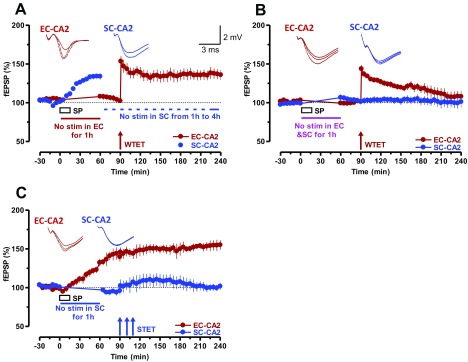Fig. S5.
Requirement of test stimulation for SP-induced STC. (A) SP was bath-applied for 15 min, during which time the baseline stimulation was suspended for 1 h in EC-CA2 but not in SC-CA2. After 1 h, EC-CA2 synapses recordings were resumed and continued for another 30 min, followed by WTET at the 90th minute. At that time, the SC-CA2 stimulation input was suspended until the end of the experiment (n = 8). In this case, SC-CA2 synapses that expressed potentiation within the first 1 h was sufficient to transform the fEPSP potentiation in EC-CA2 to an L-LTP. (B) In a similar control experiment, SC- and EC-CA2 inputs were silenced for 1 h after a stable baseline recording for 30 min. A WTET at the 90th minute in EC-CA2 failed to transform the fEPSP potentiation to an L-LTP in this case (n = 7). (C) In another set of experiment, the EC-CA2 input received normal test stimulation and displayed significant potentiation, whereas the SC-CA2 input was silenced during SP application and then for as long as 1 h. At 30 min after resuming the test stimulation, STET was applied, which failed to induce potentiation in this input (n = 6). Representative fEPSP traces 15 min before (closed line), 95 min after (dotted line), and 180 min after (hatched line) SP application or WTET/STET are depicted. In A, traces are shown up to 60 min after SP application (dotted line). Calibration bars are 2 mV/3 ms.

